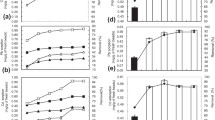Summary
Penicillium chrysogenum spores have been immobilized by adsorption on two grades of wet or dry diatomaceous earth particles, Chromosorb-W and Celite R-633. Almost 90% of the spores were adsorbed within 2 h and those remaining in suspension were removed by washing to minimise the growth of free mycelia. After germination the immobilized biomass was almost independent of the spore loading on the particles and whether or not the spore suspension was added to wet or dry particles. The free biomass obtained was less than 5% of the immobilized biomass.
Similar content being viewed by others
References
Arcuri EJ, Nichols JR, Brix TS, Santamarina VG, Buckland BC, Drew SW (1983) Thienamycin production by immobilized cells of Streptomyces cattleya in a bubble column. Biotechnol Bioeng 25:2399–2411
Deo YM, Gaucher GM (1983) Semi-continuous production of the antibiotic patulin by immobilized cells. Biotechnol Lett 5:125–130
Deo YM, Gaucher GM (1984) Semi-continuous and continuous production of penicillin-G by Penicillium chrysogenum cells immobilized in κ-carrageenan beads. Biotechnol Bioeng 26:285–295
Freeman A, Aharonowitz Y (1981) Immobilization of microbial cells in crosslinked prepolymerized, linear polyacrylamide gels: antibiotic production by immobilized cells. Biotechnol Bioeng 23:2747–2759
Gbewonyo K, Wang DIC (1983a) Confining mycelial growth to porous microbeads: A novel technique to alter the morphology of non-Newtonian mycelial cultures. Biotechnol Bioeng 25:967–983
Gbewonyo K, Wang DIC (1983b) Enhancing gas-liquid mass transfer rates in non-Newtonian fermentations by confining mycelial growth to microbeads in a bubble column. Biotechnol Bioeng 25:2873–2887
Jones A, Wood DN, Razniewska T, Gaucher GM, Behie LA (1986) Continuous production of penicillin-G by Penicillium chrysogenum cells immobilized on celite biocatalyst support particles. Can J Chem Eng 64:547–552
Kim JH, Oh DK, Park SK, Park YH, Wallis DA (1986) Production of penicillin in a fluidized-bed bioreactor using a carrier-supported mycelial growth. Biotechnol Bioeng 28:1838–1844
Mahmoud M, Rehm HJ (1986) Morphological examination of immobilized Streptomyces aureofaciens during chlorotetracycline fermentation. Appl Microbiol Biotechnol 23:305–310
Wang DIC, Meier J, Yokoyama K (1984) Penicillin fermentation in a 200-liter tower fermentor using cells confined to microbeads. Appl Biochem Biotechnol 9:105–116
Author information
Authors and Affiliations
Rights and permissions
About this article
Cite this article
Keshavarz, T., Walker, E., Eglin, R. et al. Immobilization of Penicillium chrysogenum: spore growth on Celite. Appl Microbiol Biotechnol 30, 487–491 (1989). https://doi.org/10.1007/BF00263853
Received:
Accepted:
Issue Date:
DOI: https://doi.org/10.1007/BF00263853




